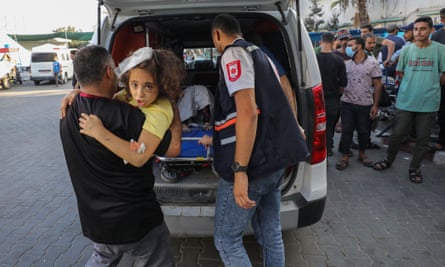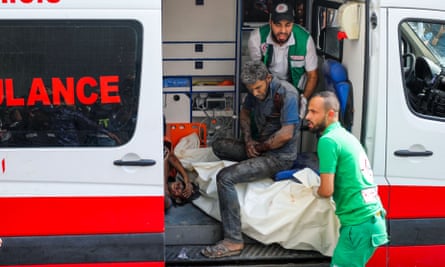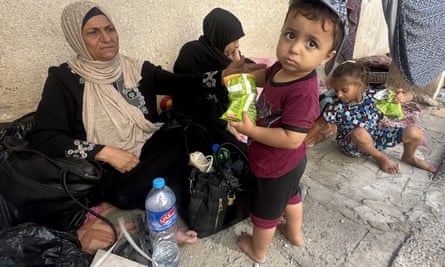At Gaza City’s Dar Al Shifa hospital, the living sleep between beds filled with patients, in corridors, and even in the grounds, while the dead overflow the morgue.
The name Dar Al Shifa translates as “house of healing”, and tens of thousands have sought not just healing but shelter from the bombardments that rained down on Gaza City every hour, praying the hospital might provide some protection. Printed blankets have been hung from the entrance courtyard’s iron handrails to provide shade, while some people have gathered around the stairwells with their children and all that remains of their belongings.
Shifa is not just Gaza’s largest medical facility, but the nerve centre of its entire healthcare system, and the Israeli assault on the territory has brought it to breaking point. Local authorities and aid groups in Gaza estimate that between 35,000 and 40,000 people are sheltering there.
“The doctors have brought their families into the hospital for safety. I slept on an operating room table last night,” said Prof Ghassan Abu-Sittah, one of the surgeons, speaking to the Guardian by phone.

“People are absolutely terrified, and so they think this is the safest place. Everything around them confirms that this is the safest place.”
He said the numbers seeking shelter presented a risk as thousands were seeking food and water where there is none. “The crowding is going to lead to an infectious disease outbreak. There is an impending public health catastrophe at Shifa hospital,” he said.
When Israeli artillery began to strike Gaza from the sky and sea, destroying whole city blocks after the Hamas militants who run the territory launched a murderous assault on Israel, many in Gaza City followed a procedure they had learned during previous attacks and fled for the hospital.
For over a decade, the grounds of the hospital have largely been spared from bombardments, apart from a strike that hit Shifa’s outpatient clinic in 2014. Instead, a wide area outside the doors to the emergency room welcomes the television crews, local politicians, healthcare workers and civilians who gather there, amid the sound of ambulance sirens and the constant sight of patients arriving on stretchers.
But this time, despite recent efforts by the International Committee of the Red Cross to renovate Shifa’s emergency room, the current crisis has tested the hospital to its limits.
Last week, Israeli officials ordered a “complete siege” of the Gaza Strip, cutting off supplies of water, food, and fuel, meaning Shifa risks losing not just losing mains power to the hospital but also the diesel supplies needed for its backup generators. Days later, the Israeli military issued an evacuation order for all 1.1 million people north of the Gaza River including Gaza City, demanding that they flee south. Shifa hospital, along with several other medical facilities, said evacuating would be impossible. The World Health Organization called the order to evacuate hospitals a “death sentence” for the thousands of sick and injured.

The assault on a territory that had already endured a 16-year blockade meant it was less than a week before Abu-Sittah was warning colleagues that the hospital was at breaking point.
There were already no beds left in Shifa, he said, and patients could not get to the operating rooms that were full of people. “All hospitals are beyond capacity,” he said. The fuel was almost out, and medical supplies were running perilously low.
The Shifa hospital morgue, with capacity for 30 bodies, quickly filled. Hospital workers were forced to stack corpses outside a walk-in refrigerator. Dozens more were laid side by side in the parking area, some in a tent and others in the sun. “The bodies are stacked up. People are too afraid to bury their dead,” said Abu-Sittah.
Abu Elias Shobaki, a nurse, told Associated Press: “Now it’s a graveyard. I am emotionally, physically exhausted. I just have to stop myself from thinking about how much worse it will get.”
Yet as other hospitals in northern Gaza were forced to close, due to either evacuation orders or fears that they would be targeted, their patients were transferred to Shifa.
“Right now, a quarter of all patients in the Gaza Strip are in Shifa,” said Dr Zaher Sahloul of MedGlobal, which is supporting medical facilities in Gaza. “It’s an added strain besides the families of the doctors and nurses, and patients, and journalists who are all sheltered there.”

The medical staff at Shifa have found themselves treating wounded family members and sometimes grieving for their own colleagues.
One evening, Dr Medhat Saidam, who had worked there since 2008, decided to accompany his sister home to where 30 of his family members were sheltering. He decided to stay with them overnight; at 1am, he was killed along with his entire family.
“We are no longer able to do anything but the most lifesaving surgeries. Not only have the supplies been exhausted, but the staff have also been exhausted,” Abu-Sittah said. “A lot of them have either been killed, or their family members have been killed, or they’re trying to secure their families.”
As a machine bleeped in the background, Abu-Sittah breathed the deep breaths of an exhausted man as he described some of the cases arriving at the hospital. “This morning we had two children from different places, both severely injured and who both carried the term ‘wounded child, no surviving family’.
“It’s one of the most heartbreaking things you can ever see. You have difficulty understanding how while the emergency department is full of screaming relatives and patients, doctors and nurses rushing round, then you come to this quiet place where there’s a trolley, and a wounded child and no one around them except the medical staff.”
He added: “This is a war against children. Even the survivors will spend the rest of their lives on their own.”
